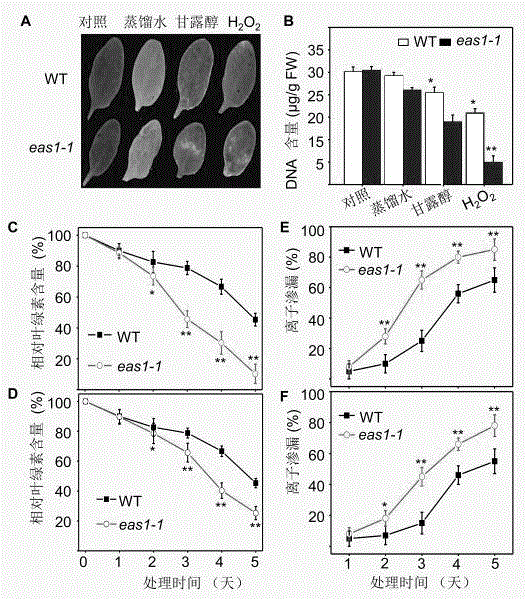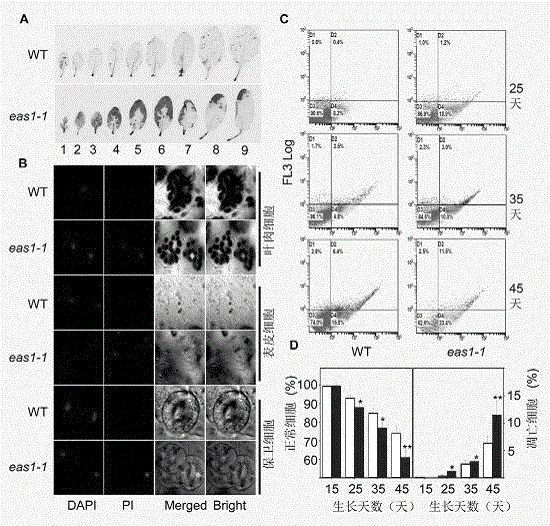Application of At1g52340 gene of arabidopsis in control over plant leaf ageing
A plant leaf, Arabidopsis technology, applied in the directions of botanical equipment and methods, applications, plant products, etc., can solve the problem of negative regulation of leaf senescence and no relevant reports have been reported.
- Summary
- Abstract
- Description
- Claims
- Application Information
AI Technical Summary
Problems solved by technology
Method used
Image
Examples
Embodiment 1
[0024] Arabidopsis At1g52340 gene is associated with leaf senescence
[0025] refer to figure 1 , Arabidopsis wild-type (wildtype, WT) and mutant (eas1-1) seeds were inoculated in 0.8% agar MS medium, cultured in light, the light / dark cycle was 16 / 8h, the temperature was 22°C, relative The humidity was 70%, WT and eas1-1 seeds germinated and grew for 7 days, then transferred to nutrient soil and placed in the greenhouse for cultivation. The maximum photochemical rate (Fv / Fm) and chlorophyll content of the leaves of WT and eas1-1 plants grown in different periods were measured, and the results showed that compared with the leaves of WT plants, the leaves of mutant eas1-1 had higher chlorophyll content and higher photosynthetic efficiency, the chlorophyll content and photosynthetic efficiency decreased significantly after 30 days ( figure 1 A-C), Premature senescence of leaves. In addition, compared with WT plants of WT and eas1-1 plants normally grown in soil, the leaf senes...
Embodiment 2
[0028] Arabidopsis At1g52340 gene regulates leaf senescence affected by osmotic and oxidative stress
[0029] refer to figure 2 , using artificial adversity stress to treat the isolated fifth leaves of WT and eas1-1 mutants with osmotic and oxidative stress, and detect their senescence phenotype, chlorophyll content and ion leakage of leaves. The data showed that compared with the WT, the leaves of the eas1-1 mutant showed significantly earlier symptoms of senescence, such as yellowing and excessive death spots ( figure 2 A); the DNA content of leaves also decreased significantly faster ( figure 2 B). The data of chlorophyll content and ion leakage also supported this view. With the prolongation of the stress time, the chlorophyll content of mutant eas1-1 detached leaves decreased significantly faster, while the ion leakage increased significantly ( figure 2 C-F).
[0030] The above results indicated that the Arabidopsis At1g52340 gene was involved in the regulation of...
Embodiment 3
[0032] Cytological Evidence for the Regulation of Leaf Senescence by the Arabidopsis At1g52340 Gene
[0033] refer to image 3 , by comparing the physiological evidence of leaf senescence staining and leaf cell death, it was found that the leaves of the mutant eas1-1 had a larger and more obvious area of decay spots than WT leaves under the condition of trypan blue staining ( image 3 A) DAPI and PI staining can more clearly show that the leaves of mutant eas1-1, whether it is mesophyll cells, leaf epidermal cells or guard cells, all show the phenomenon that the cell membrane is destroyed earlier ( image 3 B).
[0034] In order to further illustrate the senescence of the leaf cells of eas1-1, the present invention analyzes the cell loss of the mesophyll cells, observes and counts their apoptosis rate, and the results show that after 25 days, the apoptosis of the leaf cells of eas1-1 The rate was significantly higher than that of WT ( image 3 C-D).
[0035] It can be pr...
PUM
 Login to View More
Login to View More Abstract
Description
Claims
Application Information
 Login to View More
Login to View More - R&D
- Intellectual Property
- Life Sciences
- Materials
- Tech Scout
- Unparalleled Data Quality
- Higher Quality Content
- 60% Fewer Hallucinations
Browse by: Latest US Patents, China's latest patents, Technical Efficacy Thesaurus, Application Domain, Technology Topic, Popular Technical Reports.
© 2025 PatSnap. All rights reserved.Legal|Privacy policy|Modern Slavery Act Transparency Statement|Sitemap|About US| Contact US: help@patsnap.com



